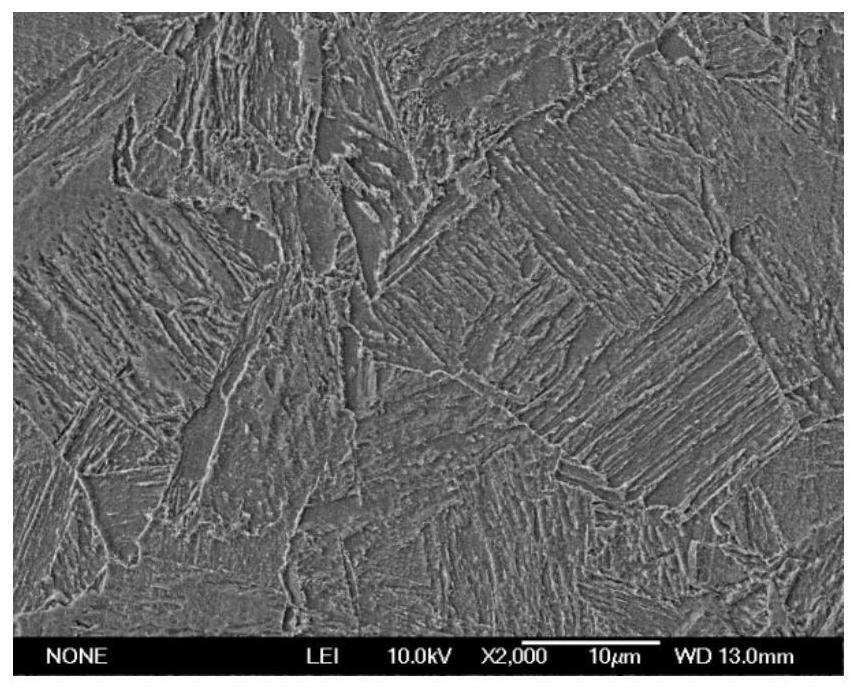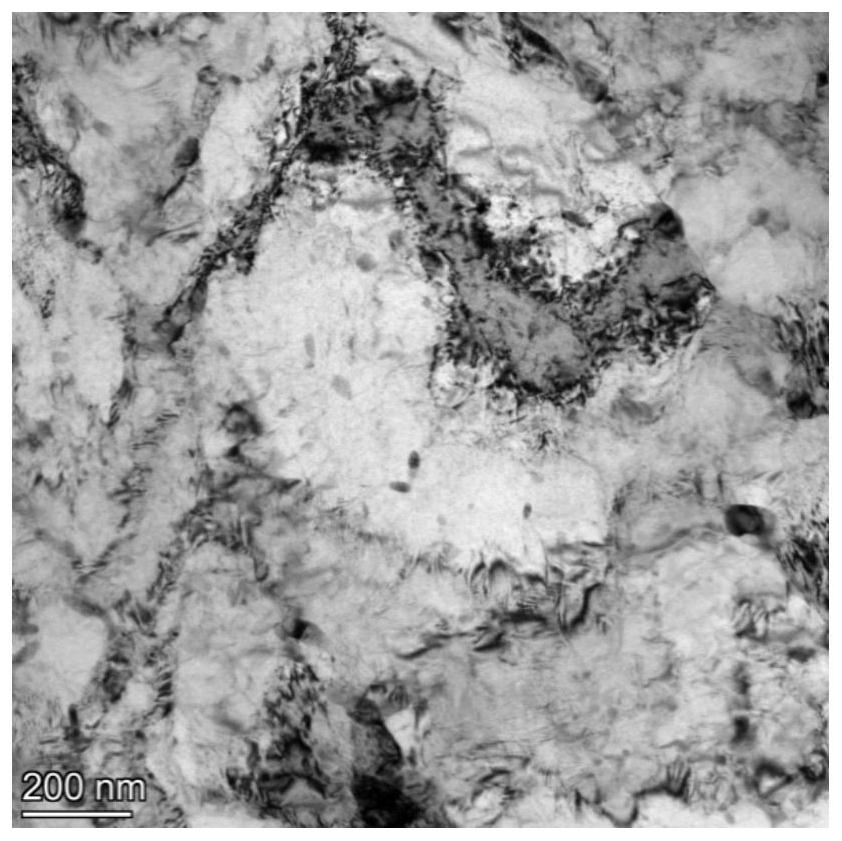Method for simultaneously improving low-carbon low-alloy steel strength and plasticity
A low-alloy steel, strength technology, applied in the field of metal materials, can solve the problems of steel strength reduction, plasticity reduction, inability to achieve strong plastic matching and other problems
- Summary
- Abstract
- Description
- Claims
- Application Information
AI Technical Summary
Problems solved by technology
Method used
Image
Examples
Embodiment 1
[0040] A method for simultaneously improving the strength and plasticity of low-carbon low-alloy steel, the steps of the method are as follows:
[0041] (1) The low-carbon low-alloy steel piece corresponding to No. 1 in Table 1 is soaked at 820°C for 0.5h for complete austenitization treatment, and then quenched in water to room temperature to obtain the quenched low-carbon low-alloy steel ;
[0042] (2) Tempering the quenched low-carbon low-alloy steel at 550° C. for 0.5 h, and cooling to room temperature in air after the tempering treatment is completed, to obtain the tempered low-carbon low-alloy steel;
[0043](3) Take a cylindrical sample with a size of φ12×18mm on the tempered low-carbon low-alloy steel, and use a separate Hopkinson pressure bar to perform dynamic large deformation treatment on the sample, with a strain of 0.4 , with a strain rate of 10 3 the s -1 , to obtain low-carbon low-alloy steel after dynamic large deformation;
[0044] (4) The low-carbon low-...
Embodiment 2
[0048] A method for simultaneously improving the strength and plasticity of low-carbon low-alloy steel, the steps of the method are as follows:
[0049] (1) The low-carbon low-alloy steel piece corresponding to No. 2 in Table 1 was subjected to a complete austenitization treatment at 880° C. for soaking and heat preservation for 1 hour, and then quenched in water to room temperature to obtain a quenched low-carbon low-alloy steel;
[0050] (2) Tempering the quenched low-carbon low-alloy steel at 450° C. for 5 hours, and cooling to room temperature in air after the tempering treatment is completed, to obtain the tempered low-carbon low-alloy steel;
[0051] (3) Take a cylindrical sample with a size of φ12×18mm on the tempered low-carbon low-alloy steel, and use the Hopkinson compression bar to carry out dynamic large deformation treatment on the sample. The strain is 0.8, and the strain Rate 10 3 the s -1 , to obtain low-carbon low-alloy steel after dynamic large deformation;...
Embodiment 3
[0056] A method for simultaneously improving the strength and plasticity of low-carbon low-alloy steel, the steps of the method are as follows:
[0057] (1) The low-carbon low-alloy steel piece corresponding to No. 3 in Table 1 was subjected to a complete austenitization treatment at 920° C. for soaking and heat preservation for 2 hours, and then quenched in water to room temperature to obtain a quenched low-carbon low-alloy steel;
[0058] (2) Tempering the quenched low-carbon low-alloy steel at 350° C. for 3 hours, and cooling to room temperature in air after the tempering treatment is completed, to obtain the tempered low-carbon low-alloy steel;
[0059] (3) Take a cylindrical sample with a size of φ12×18mm on the tempered low-carbon low-alloy steel, and use the Hopkinson compression bar to carry out dynamic large deformation treatment on the sample. The strain is 1.2, and the strain Rate 10 3 the s -1 , to obtain low-carbon low-alloy steel after dynamic large deformation...
PUM
| Property | Measurement | Unit |
|---|---|---|
| yield strength | aaaaa | aaaaa |
| elongation | aaaaa | aaaaa |
| thickness | aaaaa | aaaaa |
Abstract
Description
Claims
Application Information
 Login to View More
Login to View More - R&D
- Intellectual Property
- Life Sciences
- Materials
- Tech Scout
- Unparalleled Data Quality
- Higher Quality Content
- 60% Fewer Hallucinations
Browse by: Latest US Patents, China's latest patents, Technical Efficacy Thesaurus, Application Domain, Technology Topic, Popular Technical Reports.
© 2025 PatSnap. All rights reserved.Legal|Privacy policy|Modern Slavery Act Transparency Statement|Sitemap|About US| Contact US: help@patsnap.com



